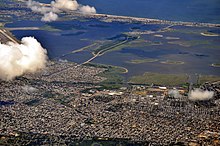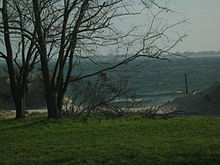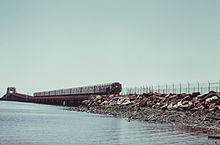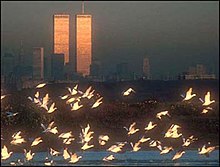Jamaica Bay
| Jamaica Bay | |
|---|---|
| Grassy Bay | |
 Map of Jamaica Bay, with subway lines and major roads | |
| Location | New York City and Nassau County |
| Coordinates | 40°37′04″N 73°50′33″W / 40.61778°N 73.84250°W |
| Etymology | Lenape |
| Primary outflows | Rockaway Inlet |
Jamaica Bay is an estuary on the southern portion of the western tip of Long Island, in the U.S. state of New York. The estuary is partially man-made, and partially natural. The bay connects with Lower New York Bay to the west, through Rockaway Inlet, and is the westernmost of the coastal lagoons on the south shore of Long Island. Politically, it is primarily divided between the boroughs of Brooklyn and Queens in New York City, with a small part touching Nassau County.
The bay contains numerous marshy islands. It was known as Grassy Bay as late as the 1940s. Jamaica Bay is located adjacent to the confluence of the New York Bight and New York Bay, and is at the turning point of the primarily east-west oriented coastline of southern New England and Long Island and the north-south oriented coastline of the mid-Atlantic coast.
Etymology
The name derives from the nearby town of Jamaica, which in turn derives from Yameco, a corruption of a word for "beaver" in the Lenape language spoken by the Native Americans who lived in the area at the time of first European contact.[1] The liquid "y" sound of English is spelled with a "j" in Dutch, the language of the first people to write about the area; the English retained this Dutch spelling, but, after repeated reading and speaking of "Jamaica", slowly replaced the liquid sound with the hard "j" of the English pronunciation of the name today.[2] (In the Caribbean, the aboriginal Arawaks named their island Xaymaca, "land of wood and water", and the "x" spelling in Spanish was in time transformed to the hard "j" of the modern English name, "Jamaica".)[3]
Ecology
The location of Jamaica Bay, combined with its rich food resources, make it an important habitat for both plants and animals.[4] This geographic location also provides valuable feeding habitat to marine and estuarine species migrating between the New York Bight and the Hudson River and Raritan River estuaries, and to a diverse community of migratory birds and insects that use the Bay for refueling during transit between summer breeding and overwintering grounds.[5] While the resident wildlife of Jamaica Bay are poorly studied, survey data indicate that Jamaica Bay and the Rockaways support seasonal or year-round populations of at least 325 bird species, more than 100 species of fish, and more than 80 butterfly species.[4]
Geography

Jamaica Bay is a
Jamaica Bay is in the southern portion of the New York metropolitan area, and the uplands around the bay, as well as much of the Rockaway barrier beach, are dominated by urban residential, commercial, and industrial development. The bay itself has been disturbed by dredging, filling, and development. About 49 square kilometres (19 sq mi) of the original 65 square kilometres (25 sq mi) of wetlands in the bay have been filled in, mostly around the perimeter of the bay. Extensive areas of the bay have been dredged for navigation channels and to provide fill for the airports and other construction projects. This includes John F. Kennedy International Airport (commonly known as JFK Airport) on the northeastern side of the bay, as well as the historic and now-defunct Floyd Bennett Field on the western side.[6]
The center of the bay is dominated by
History
Historic seaport proposal


Some modifications to Jamaica Bay were conducted in the early 20th century as a result of a never-realized plan to develop Jamaica Bay as a seaport. As early as 1886, the U.S. Engineering Department (now
In 1910, developers unveiled a plan to convert Jamaica Bay to a seaport district as part of the
The project began in 1911,[10] despite doubts about the feasibility of the project. Some engineers believed that shifting sand dunes and the tides in Jamaica Bay might make it impossible to construct the seaport district.[11][8] The next year, developers began dredging ports within Jamaica Bay in order to make it navigable for the large vessels that were supposed to use the bay.[12][13] Significant progress on the dredging had been completed by 1918, and the city allowed the construction of several piers.[10] However, only one pier was built near Barren Island. The pier, which was built in order to receive landfill for the other proposed piers, stretched 1 mile (1.6 km) northeast and was 700 feet (210 m) wide.[14] A total of six such piers were planned for this area.[15] In June 1918, a 447-foot-long (136 m) municipally owned pier was opened at Mill Basin. At the time, there were proposals to fill in 8,000 acres (3,200 ha) between Mill and Barren Islands so 14 more piers could be built.[16] With the United States' entry into World War I, the project was abandoned.[17][8]
The plans were revived by 1927. At the time, the docklands were expected to gain a connection to the
In January 1931, the
Incidents
On March 1, 1962,
On November 12, 2001, American Airlines Flight 587, an Airbus A300, crashed after takeoff from JFK Airport after its vertical stabilizer separated in-flight and landed in Jamaica Bay. The aircraft crashed into Belle Harbor, Queens. All 260 people on board were killed, as well as five more people on the ground.[32]
Environmental conditions

The
As of Spring 2003, marshland is being lost at the rate of approximately 40 acres (160,000 m2) per year. The reasons for this loss are still unclear, but one hypothesis is that the loss is the result of rising sea levels. To test this, in the hope of preventing further losses, the National Park Service plans to dredge a small area of the bay in order to build up the soil in about 1 acre (4,000 m2) of marsh. Opponents are concerned that the dredging may be harmful, perhaps leading to greater loss of marshland than the area saved.
Other scientists suggest that the 3,500 lb (1,600 kg) of nitrogen pouring into the bay every day, 92 percent from four sewage treatment plants ringing the bay, may be partly to blame. They hypothesize that the high levels of nitrogen may stimulate the growth of sea lettuce, smothering other plants. The excess energy may also cause smooth cordgrass to reallocate energy from its roots to its shoots, making it harder for marsh soil to hold together.[33]
In an effort to reduce the amount of nitrogen being discharged into Jamaica Bay, the New York City Department of Environmental Protection announced the installation of enhanced treatment measures that will cut nitrogen discharges by 4,000 pounds a day. An innovative technology, called the Ammonia Recovery Process, is now being designed by ThermoEnergy Corporation, which will further reduce nitrogen discharges from the bay by 3,000 pounds per day by 2014.[34][35]
Ownership and protection status

The majority of land and water within this complex is owned by the United States federal government, and the city of New York. Most of Jamaica Bay proper and portions of the uplands and barrier beach are part of the Gateway National Recreation Area's Jamaica Bay Unit. Administered by the National Park Service, the Jamaica Bay Unit includes the 9,100 acres (37 km2) of Jamaica Bay Wildlife Refuge, as well as Breezy Point Tip, Fort Tilden, Jacob Riis Park and Floyd Bennett Field. There are two state parks at Jamaica Bay, Shirley Chisholm, and Bayswater Point.
There are several city parks within the bay complex, including Marine Park, Spring Creek Park and Rockaway Community Park, and numerous smaller parcels of city-owned land such as Tribute Park and Sunset Cove at Broad Channel. Portions of the wetlands and uplands are part of JFK Airport, owned by the city of New York and operated by the Port Authority of New York and New Jersey. Occasionally the airport becomes a route of migration of some wildlife species disrupting the traffic.[36][37] Small areas in the upland buffer around the bay and on the Rockaway Peninsula remain in private residential or commercial ownership.
Jamaica Bay has been designated and mapped as an otherwise protected beach unit pursuant to the federal
Science and Resilience Institute at Jamaica Bay
In 2012, the City of New York and the National Park Service signed an agreement to jointly manage Jamaica Bay and restore its parkland and greenspaces.[38] Hurricane Sandy hit the city in force in October 2012, causing billions of dollars of damage, and inundating coastal regions, including Jamaica Bay, with a storm surge estimated at close to 2.5 meters.[39] The impact of Hurricane Sandy revealed the vulnerability of the city's coastal infrastructure to storm surges, and with projections suggesting that the frequency of such storms is likely to increase over the coming century,[40] New York City released "A Stronger, More Resilient New York"[41] in June 2013, an extensive report outlining a plan to reinforce and rebuild NYC infrastructure in order to create a city better able to withstand future storms. Later that year, Mayor Bloomberg, together with the then Secretary of the Interior Sally Jewell, announced the establishment of the Jamaica Bay Science and Resilience Institute, a multidisciplinary consortium of academic, governmental and community partners coordinated by the City University of New York.[42] The Institute, subsequently renamed the Science and Resilience Institute at Jamaica Bay (SRIJB), is currently housed at Brooklyn College, but will be relocating to a permanent home at Floyd Bennett Field within the next 3 years..
See also
- Beach Channel Drive, a drive along the Rockaways that borders the Jamaica Bay shore
- Cross Bay Veterans Memorial Bridge, a bridge connecting the Rockaway Peninsula to Howard Beach and mainland Queens
- Geography of New York City
- Geography of New York–New Jersey Harbor Estuary
- Marine life of New York–New Jersey Harbor Estuary
- Ruffle Bar, island in Jamaica Bay
References
Notes
- ^ "What Is Jamaica, Queens, Named After?". The New York Times. July 6, 2014. Retrieved April 6, 2019.
- ^ Major Mark Park, accessed December 16, 2006
- ^ Lonely Planet. "History of Jamaica – Lonely Planet Travel Information". Retrieved January 7, 2015.
- ^ ISBN 978-1-61091-734-6, retrieved September 21, 2022
- ^ US Fish and Wildlife Service. "Significant habitats and habitat complexes of the New York bight watershed: Jamaica Bay and Breezy Point. Complex# 16." Significant habitats and habitat complexes of the New York bight watershed. US Fish and Wildlife. Charlestown, RI: Fish and Wildlife Service, Southern New England—New York Bight Coastal Ecosystems Program (1997).
- ^ Black 1981, p. 61.
- ^ a b c Cody et al 2009, p. 45.
- ^ a b c Black 1981, p. 73.
- ^ a b c "A Vast Project For Transforming New York's Marshlands.; JAMAICA BAY TO BECOME A GREAT WORLD HARBOR" (PDF). The New York Times. March 13, 1910. Retrieved January 8, 2018.
- ^ a b Cody et al 2009, p. 46.
- ^ Cody et al 2009, p. 92.
- ^ "Marine Park Highlights". New York City Department of Parks & Recreation. June 17, 2003. Retrieved January 6, 2018.
- ^ Cody et al 2009, pp. 29, 46.
- ^ Black 1981, pp. 77–79.
- ^ a b "JAMAICA BAY WORLD HARBOR; Six 1,000-Foot Piers to Be Installed as a Beginning" (PDF). The New York Times. July 31, 1921. Retrieved January 22, 2018.
- ^ "MAYOR OPENS CITY'S JAMAICA BAY PIER; Other Officials Take Part In Dedication of Mill Basin as a Port. DANIELS'S LETTER BY AIR Lieut. Kilgore Drops Secretary's Message of Congratulation into the Water, but It Is Rescued" (PDF). The New York Times. June 2, 1918. Retrieved January 21, 2018.
- ^ Cody et al 2009, p. 47.
- newspapers.com.
- ^ Black 1981, p. 71.
- ^ "URGES CITY TO RUSH JAMAICA BAY WORK; Hager Tells Long Island Cruise Members of Plan to Have $12,000,000 Set Aside. PROJECT INCLUDES AIRPORT Bullard Says Sheepshead Bay Seeks Breakwater, Wider Channel and a Mooring Place" (PDF). The New York Times. July 28, 1928. Retrieved January 22, 2018.
- ^ "PROJECTS BIG PORT ABOUT JAMAICA BAY; The Port Authority Offers to Construct $2,000,000 Rail Link to Develop Area. WOULD LEASE IT TO CITY Five-Mile Line Connecting With the Long Island Would Permit 150 Miles of New Piers. Letter Describes Project. PROJECTS BIG PORT ABOUT JAMAICA BAY" (PDF). The New York Times. November 27, 1929. Retrieved January 22, 2018.
- ISSN 0362-4331. Retrieved January 20, 2018.
- ^ "Jamaica Bay Plan Approved by City" (PDF). The New York Times. January 31, 1931. Retrieved April 3, 2012.
- ISSN 0362-4331. Retrieved January 20, 2018.
- ISSN 0362-4331. Retrieved January 20, 2018.
- OCLC 834874.
- ISSN 0362-4331. Retrieved January 22, 2018.
- ISSN 0362-4331. Retrieved January 22, 2018.
- ISSN 0362-4331. Retrieved January 20, 2018.
- ^ AP (March 2, 1962). "Tides Hampering Hunt for Victims". The Spokesman-Review. Spokane, WA. p. 1. Retrieved November 22, 2009.
- ^ American Airlines, Inc., Boeing 707-123B N 7506A, Jamaica Bay, Long Island, New York, March 1, 1962. Civil Aeronautics Board. January 15, 1963. Docket No. SA-366. File No. 1-0001. Archived from the original (web archive) on May 28, 2015. Retrieved September 23, 2010.
(Navigate: Historical Aircraft Accident Reports (1934-1965)→ 1962→ American Airlines) - ^ In-Flight Separation of Vertical Stabilizer, American Airlines Flight 587, Airbus Industrie A300-605R, N14053, Belle Harbor, New York, November 12, 2001 (PDF) (Report). National Transportation Safety Board. October 26, 2004. NTSB/AAR-04/04. Archived (PDF) from the original on April 30, 2017. Retrieved July 3, 2017.
- ^ Benotti, Mark J., Michael Abbene, and Stephen A. Terracciano. "Nitrogen Loading in Jamaica Bay, Long Island, New York: Predevelopment to 2005." United States Geological Survey Scientific Investigations Report 2007-5051.
- ^ New York City Department of Environmental Protection. "DEP Launches New Measures to Improve Overall Ecology of Jamaica Bay" Accessed 2010-06-30.
- ^ "ThermoEnergy Corporation Signs Contract with City of New York to Help Improve Overall Ecology of Jamaica Bay" (Press release). Thermoenergy. June 30, 2010. Retrieved July 1, 2010.
- ^ Cohen, Zachary (June 29, 2011). "Turtles Stop Traffic at New York's JFK Airport, Promptly Get a Twitter Account". Time.
- ^ Newman, Andy (June 29, 2011). "Delays at J.F.K.? This Time, Blame Turtles". The New York Times.
- ^ "The Institute – Science and Resilience Institute". Retrieved October 20, 2022.
- )
- PMID 27790992.
- ^ "A Stronger, More Resilient New York | U.S. Climate Resilience Toolkit". toolkit.climate.gov. Retrieved October 20, 2022.
- ^ "Jamaica Bay Science And Resilience Institute Will Investigate Natural Storm Resistance Defenses". Bklyner. August 13, 2013. Retrieved October 20, 2022.
Sources
- Black, Frederick R. (1981). "JAMAICA BAY: A HISTORY" (PDF). United States Department of the Interior, National Park Service.
{{cite journal}}: Cite journal requires|journal=(help) - Cody, Sarah K.; Auwaerter, John; Curry, George W. (2009). "Cultural Landscape Report for Floyd Bennett Field" (PDF). nps.gov. State University of New York, College of Environmental Science and Forestry.
- Keys, C.M. (November 1910). "The Sea-Gate Of The Continent: ... The Flats Of New Jersey And Of Brooklyn The Ultimate Solution Of The Problem". The World's Work: A History of Our Time. XXI: 13655–13673. Retrieved July 10, 2009. A c. 1910 plea to develop a harbor at Jamaica Bay.
- Hartig, Ellen K. and Gornitz, Vivien (1981). "The Vanishing Marshes of Jamaica Bay: Sea Level Rise or Environmental Degradation?" (New York: National Aeronautics and Space Administration, Goddard Institute for Space Studies).
- U.S. Fish and Wildlife Service, Charlestown, RI (1997). Significant Habitats and Habitat Complexes of the New York Bight Watershed: Jamaica Bay and Breezy Point." Archived 2016-02-05 at the Wayback Machine Southern New England – New York Bight Coastal Ecosystems Program.
External links
- Jamaica Bay Wildlife Refuge — Visitor Information from National Parks of the New York Harbor Conservancy.
- Official Gateway National Recreation Area website
- Jamaica Bay Research and Management Information Network — Community-driven knowledge base of past, present, and future activities in Jamaica Bay.

